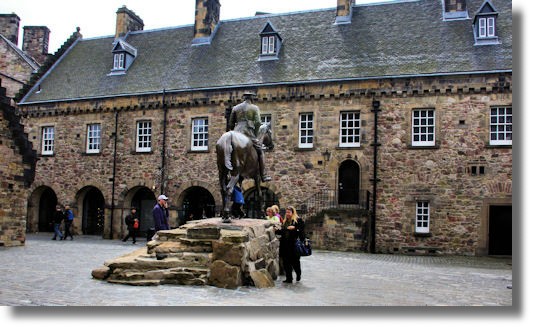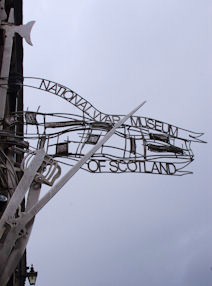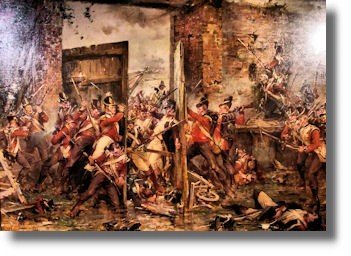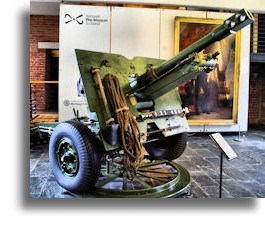
National War Museum with Statue of Earl Haig
Places to Visit in Scotland
- National War Museum of Scotland

National War Museum with Statue of Earl Haig
The Building

The National War Museum of Scotland is housed in former storehouses around a courtyard in Edinburgh Castle, behind the Governor's House. Although there are signs pointing to it, it is down a slope and can easily be missed. Indeed, when I mentioned that I had visited the National War Museum to some Edinburgh friends I was greeted with blank looks and asked "Where is that?" Of course, although over a million tourists call in at the castle, many Edinburgh residents have never been inside the building that overlooks the city's busiest shopping street. (Similarly, many Glaswegians have never been inside Glasgow Cathedral). Inside the War Museum, the layout is complicated by the fact that the museum is housed in two buildings, connected by a long corridor and one of the buildings has a ground and upper floor.
Scottish Soldiers
Ever since the union of Scotland and England with the Union of the Parliaments in 1707, Scottish regiments have been an important element of the British Army and made an important contribution to the expansion of the British Empire in the 18th and 19th centuries. Although there are no accurate statistics, it is usually accepted that Scotland contributed more soldiers to the British Army as a percentage of its population than any other component part of the United Kingdom. After the Jacobite Uprising of 1745, the British Government created Scottish regiments whose uniform included the kilt - but standard red tunics. Many Scottish units wore the kilt in combat during the First World War but in the muddy trenches of Flanders it was found to be totally impractical and was phased out except for full dress occasions. But the ferocious fighting by the Royal Highland Regiment early in the First World War led to their acquiring the nickname "Ladies from Hell" from the German troops that faced them in the trenches.
Thin Red Line
The Thin Red Line was a military action by the Sutherland Highlanders red-coated 93rd (Highland) Regiment at the Battle of Balaclava on 25 October 1854, during the Crimean War. In this incident the 93rd aided by a small force of Royal Marines and some Turkish infantrymen, led by Sir Colin Campbell, routed a Russian cavalry charge. Previously Campbell’s Highland Brigade had taken part in actions at the Battle of Alma and the Siege of Sevastopol. There were more Victoria Crosses presented to the Highland soldiers at that time than at any other. In reality, the 93rd's survival was due to the caution of the Russian commander, who believed that such a small infantry force could not hope to hold out a full cavalry charge and thus must be a diversion and ordered his men to disengage. The event nonetheless was used in the British press and became an icon of the qualities of the red coat in a war that was in reality poorly managed and increasingly unpopular.This iconic painting "The Thin Red Line" is by Robert Gibb who died in 1932. It was inspired by Alexander Kinglake's account of the 93rd Highlanders action at Balaclava in his book "The Invasion of the Crimea."
Medals and Honours
The War Museum has a number of displays showing the medals and honours awarded to many Scots as a result of their bravery in action.
The medals here were all awarded to Corporal Archibald Greenwood of the Seaforth Highlanders from 1878 to 1918. He is believed to have received more medals than any other non-commissioned soldier in the British army. He joined the 72nd Highlanders in 1878 aged 19. The medals include an Afghanistan Medal, a Kabul to Kandahar Star, Egypt Medal, Queen's Sudan Medal, Khedive's Sudan Medal 1896-1908, Khedive's Star for Egypt Long Service and Good Conduct Medal awarded in 1897 for 18 years service, Queen's South Africa Medal and the Royal Humane Society Stanhope Bronze Medal awarded for saving life on two occasions during the Nile expedition in 1898. At the age of 40, Greenwood had volunteered to rejoin the army for the South African War and served there with the 3rd Argyll and Sutherland Highlanders. At age 55 Greenwood again rejoined the army and served with the 5th battalion Seaforth Highlanders and was awarded the British War Medal 1914-20, Victory Medal 1914-19, Meritorious Service Medal awarded for distinguished service during a First World War bombing raid.
Naval Battles
The War Museum displays a number of paintings of famous battles in which Scots were in command of the Royal Navy fleet involved. One of the best known is the Battle of Camperdown a major naval action fought on 11 October 1797 between a Royal Navy fleet under Admiral Adam Duncan (the second son of Alexander Duncan of Lundie, Angus, a Provost of Dundee) and a Dutch Navy fleet under Vice-Admiral Jan de Winter. The battle was the most significant action between British and Dutch forces during the French Revolutionary Wars and resulted in a complete victory for the British, who captured eleven Dutch ships without losing any of their own. When British forces confronted the Dutch Navy again two years later, the Dutch sailors refused to fight and their ships surrendered en masse. Admiral Duncan (1731 – 1804) later became 1st Viscount Duncan.
Aviation
There is not a lot on aviation in the War Museum in Edinburgh Castle but there is an evocative painting of a World War II Short Stirling bomber named "MacRobert's Reply" in memory of two brothers, both pilots who were killed on active service with the Royal Air Force. The aircraft was named at the request of Lady MacRobert who donated £25,000 to pay for a bomber as "a mother's immediate reply" to the loss of her sons. The gift and its spirit of defiance was widely reported in the national press at the time. The aircraft had the MacRobert coat of arms painted on to its nose.
Slide Show of Pictures From National War Museum

This page can only display a few of the exhibits in the National War Museum and most of these at a small size. So there is a slide show with thumbnails and larger sized versions on separate pages. See National War Museum - Slide Show The illustration here is of a scene from the Battle of Waterloo in 1815 - "Closing the gates at Hougoumont" - when men of the Coldstream Regiment of Foot Guards and the 3rd (Scots) Foot Guards shut the gates of the chateau of Hougoumont against French attack. Hougoumont was a vital strategic point on the battlefield and the victorious Duke of Wellington stated that "the success of the battle of Waterloo turned on the closing of the gates."

Conclusions
The War Museum has many exhibits on display showing the heroism and contribution made by Scots in conflicts over the last few hundred years. The bulk of the displays concentrate on the 18th and 19th centuries, however. While there are some film excerpts where you can sit and watch the action, there is very little on the 20th century exploits, far less more recent campaigns. (The Black Watch Museum at Balhousie Castle in Perth does better from that point of view).I have been to the War Museum on a previous occasions but decided then not to create a "Places to Visit" page as the exhibits are, in the main, dimly lit, making it difficult for visitors to take photographs. More recent digital cameras can just about cope (though glass in front of many of the displays often creates intrusive reflections).
Return to Index of Places to Visit
Where else would you like to go in Scotland?

